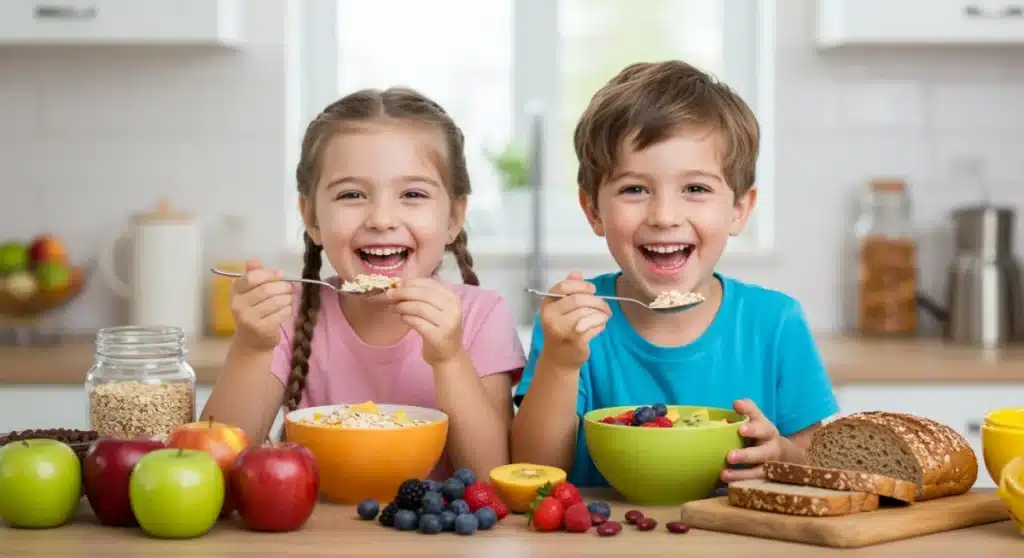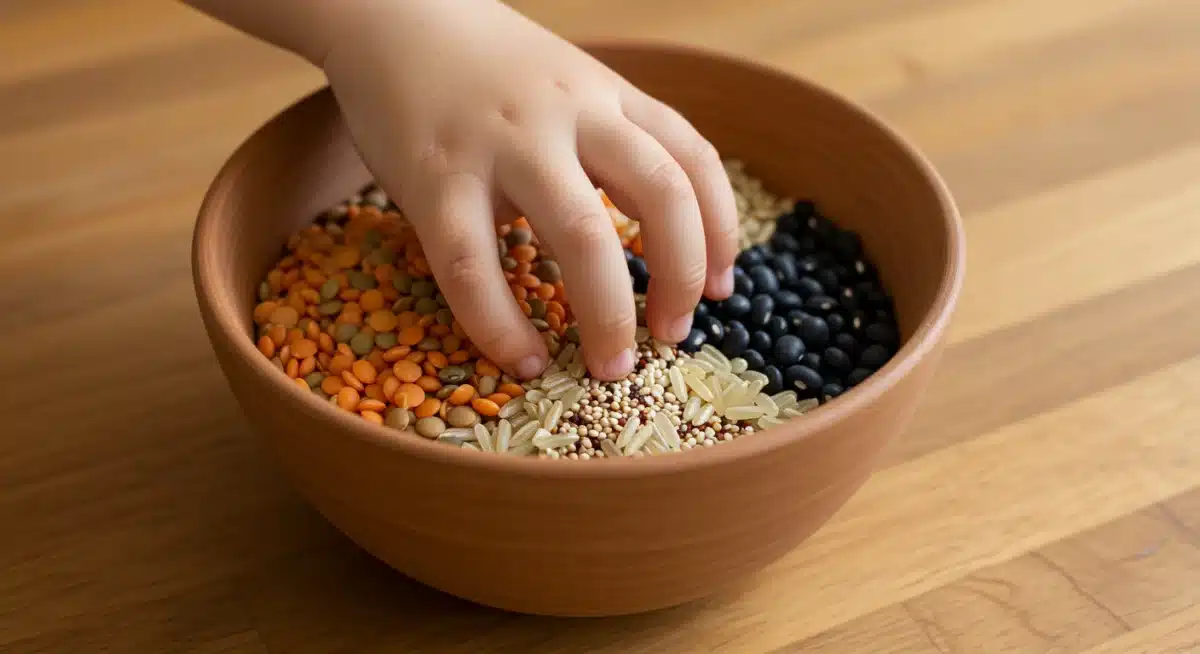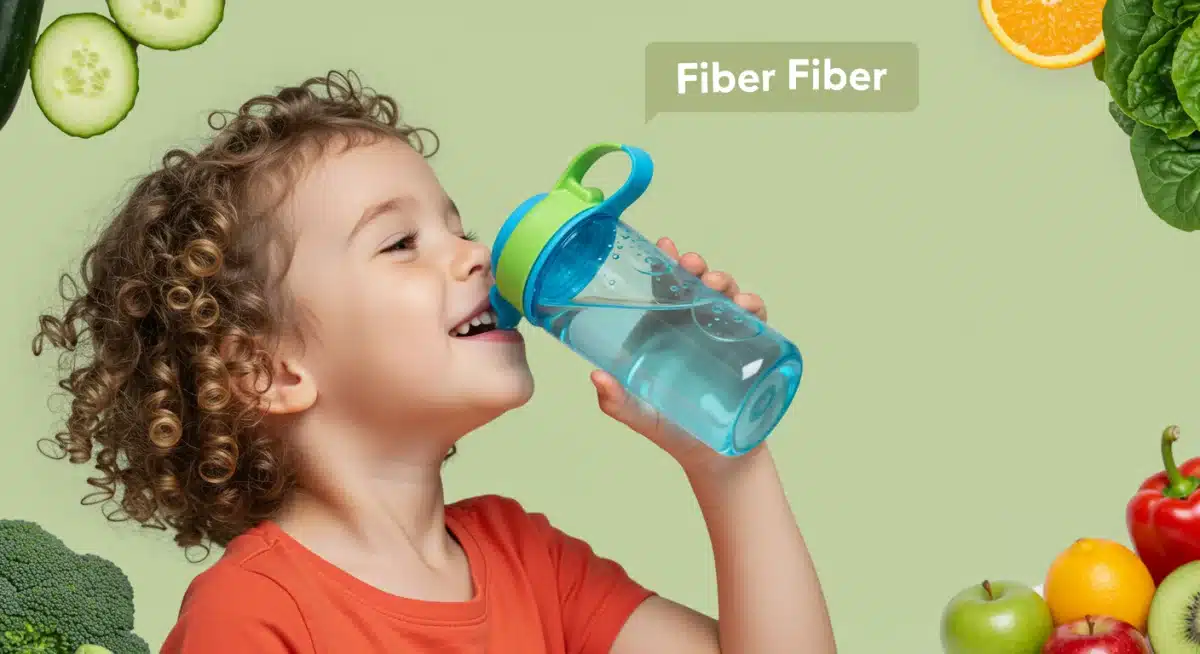Fiber-Rich Foods for Kids: Preventing Constipation & Promoting Digestive Health

Advertisement
Incorporating fiber-rich foods into a child’s diet is crucial for preventing constipation and promoting robust digestive health, laying a strong foundation for their overall well-being and development.
As parents, we constantly strive to provide the best for our children, and their nutrition is undoubtedly at the top of that list. One area that often causes concern, yet is easily manageable with the right dietary choices, is digestive health. Specifically, understanding the profound impact of fiber-rich foods for kids: preventing constipation and promoting digestive health is paramount for their comfort and long-term well-being.
Understanding the Role of Fiber in Children’s Diets
Fiber, a type of carbohydrate that the body cannot digest, plays a crucial role in maintaining a healthy digestive system. For children, adequate fiber intake is particularly important because it helps regulate bowel movements, preventing common issues like constipation that can cause significant discomfort and distress.
Advertisement
Beyond regularity, fiber contributes to overall gut health by feeding beneficial gut bacteria, which in turn supports a stronger immune system and even impacts mood and cognitive function. Ensuring your child gets enough fiber is not just about avoiding problems; it’s about building a resilient foundation for their health from the inside out.
The Two Types of Fiber and Their Benefits
Fiber comes in two main forms, each offering distinct benefits for children’s digestive health. Understanding these differences can help parents make informed dietary choices.
- Soluble Fiber: This type dissolves in water to form a gel-like substance. It helps soften stool, making it easier to pass, and can also help regulate blood sugar levels and lower cholesterol.
- Insoluble Fiber: This fiber does not dissolve in water. It adds bulk to stool, promoting regular bowel movements and preventing constipation by speeding up the passage of food through the digestive tract.
- Balanced Intake: A healthy diet for children should include a good balance of both soluble and insoluble fiber to maximize digestive benefits.
It’s vital to remember that while fiber is beneficial, a sudden increase in intake without adequate fluid can sometimes worsen constipation. Therefore, a gradual introduction of fiber-rich foods alongside plenty of water is the most effective approach for children.
Advertisement
Top Fiber-Rich Fruits for Kids
Fruits are often a child’s first introduction to solid foods, and thankfully, many are packed with essential fiber. Incorporating a variety of fruits into daily meals and snacks can make a significant difference in preventing constipation and ensuring smooth digestion for your little ones.
The natural sweetness of fruits makes them an appealing choice for children, and their vibrant colors can make mealtime more exciting. From berries to apples, there’s a wide array of options to explore, each offering unique nutritional advantages.
Delicious and Nutritious Fruit Choices
Making fiber fun and accessible is key to children embracing healthy eating habits. Here are some excellent fruit options that are both tasty and beneficial:
- Berries: Strawberries, blueberries, raspberries, and blackberries are bursting with flavor and fiber. A cup of raspberries, for instance, can provide a substantial amount of daily fiber. They are great in smoothies, oatmeal, or as a standalone snack.
- Apples: An apple a day truly can keep the doctor away, especially when it comes to digestive issues. Remember to leave the skin on, as that’s where much of the insoluble fiber resides. Sliced apples with a dollop of nut butter make a satisfying snack.
- Pears: Similar to apples, pears are an excellent source of fiber, particularly if eaten with the skin. Their soft texture makes them easy for younger children to chew.
- Prunes: Often recommended for constipation, prunes are a powerhouse of fiber and natural laxatives. While not always a child’s favorite, small amounts of prune juice or pureed prunes can be very effective.
- Bananas: While not as high in fiber as some other fruits, bananas still contribute to overall fiber intake and are gentle on a sensitive stomach, making them a good choice for toddlers.
Encouraging children to eat a rainbow of fruits ensures they receive a broad spectrum of vitamins, minerals, and antioxidants, alongside their much-needed fiber. Presenting fruits in engaging ways, such as fruit skewers or colorful salads, can also boost their appeal.
Vegetables That Boost Digestive Health in Children
Vegetables are another cornerstone of a fiber-rich diet for kids. While sometimes a harder sell than fruits, introducing a variety of vegetables early and consistently can help children develop a taste for these essential foods. They are packed with both soluble and insoluble fiber, along with an abundance of vitamins and minerals.
Getting kids to eat their veggies often requires creativity and persistence. However, the benefits for their digestive health and overall growth are well worth the effort. From leafy greens to root vegetables, there are countless ways to incorporate them into family meals.
Making Vegetables Appealing to Picky Eaters
Many parents face the challenge of getting their children to eat vegetables. Here are some strategies and excellent vegetable choices that are high in fiber:
- Broccoli: A fantastic source of fiber, broccoli can be steamed, roasted, or even hidden in sauces. Roasting it with a little olive oil and seasoning can bring out its natural sweetness.
- Carrots: Sweet and versatile, carrots are great raw as a snack with hummus, or cooked in soups, stews, and stir-fries. They provide both soluble and insoluble fiber.
- Sweet Potatoes: These naturally sweet root vegetables are rich in fiber, vitamins, and minerals. They can be baked, mashed, or cut into fries, making them a popular choice for kids.
- Spinach: While some kids might balk at leafy greens, spinach can be easily blended into smoothies, mixed into pasta sauces, or sautéed and added to eggs without significantly altering the taste.
- Peas: Small, sweet, and easy to eat, peas are a good source of fiber and can be added to almost any meal, from rice dishes to casseroles.
Experimenting with different cooking methods and presentations can help make vegetables more palatable for children. Remember, repeated exposure often leads to acceptance, so keep offering a variety of options without pressure.
Whole Grains and Legumes: Powerhouses of Fiber
Beyond fruits and vegetables, whole grains and legumes are indispensable components of a fiber-rich diet for children. These food groups provide sustained energy, essential nutrients, and a significant boost to digestive health, making them crucial for preventing constipation.
Many parents might overlook the fiber content in these categories, but incorporating them regularly can significantly contribute to a child’s daily fiber intake. They are versatile, affordable, and can be integrated into a wide range of family meals.
Incorporating Grains and Legumes into Daily Meals
Making smart substitutions and additions can help increase whole grain and legume consumption in children:
- Oatmeal: A warm bowl of oatmeal for breakfast is an excellent way to start the day with fiber. Top it with berries or sliced fruit for an extra fiber punch.
- Whole Wheat Bread/Pasta: Swapping white bread and pasta for their whole wheat counterparts is a simple yet effective way to increase fiber. Look for products labeled “100% whole wheat.”
- Brown Rice: A healthier alternative to white rice, brown rice offers more fiber and nutrients. It pairs well with many dishes.
- Lentils: These tiny powerhouses are incredibly versatile and rich in fiber. They can be added to soups, stews, curries, or even made into a vegetarian taco filling.
- Beans (Black Beans, Kidney Beans, Chickpeas): Beans are nutritional superstars, packed with fiber and protein. They can be incorporated into salads, burritos, chili, or pureed into dips like hummus.
Gradual changes are often best when introducing new textures and flavors to children. Start by mixing whole grains with refined grains, or adding small amounts of legumes to familiar dishes, slowly increasing the proportion over time.

Practical Tips for Increasing Fiber Intake
Getting children to eat enough fiber doesn’t have to be a battle. With a little creativity and consistency, parents can seamlessly integrate more fiber-rich foods into their children’s daily routines. The goal is to make healthy eating a natural and enjoyable part of family life.
It’s about creating positive associations with food and making nutritious choices readily available. Small, consistent efforts can lead to significant long-term benefits for a child’s digestive health and overall well-being.
Strategies for Success
Here are some actionable tips to help boost your child’s fiber intake:
- Start Small and Gradual: Don’t overhaul their diet overnight. Introduce new fiber-rich foods slowly to allow their digestive system to adjust and prevent discomfort.
- Offer Variety: Rotate different fruits, vegetables, whole grains, and legumes to keep meals interesting and ensure a broad spectrum of nutrients.
- Make it Fun: Use cookie cutters to create fun shapes from fruits and vegetables, or arrange food into playful designs on the plate. Involve children in meal preparation to increase their interest.
- Hydration is Key: Fiber works best when accompanied by adequate fluid intake. Encourage your child to drink plenty of water throughout the day. This helps fiber move through the digestive system smoothly.
- Lead by Example: Children are more likely to eat what they see their parents eating. Make fiber-rich foods a regular part of your own diet.
- Sneaky Fiber: Blend vegetables into sauces, smoothies, or baked goods. Add pureed beans to brownies or black bean burgers.
Consistency is more important than perfection. Every small step towards a more fiber-rich diet contributes to better digestive health for your child. Celebrate their willingness to try new foods and make mealtime a positive experience.
Addressing Constipation: When Fiber Isn’t Enough
While a diet rich in fiber is the primary defense against constipation in children, there are instances where dietary changes alone may not be sufficient. It’s important for parents to recognize when additional steps or professional advice might be necessary to ensure their child’s comfort and health.
Understanding the signs of chronic constipation and knowing when to seek help can prevent prolonged discomfort and more serious health issues. While fiber is a powerful tool, it’s part of a larger picture of digestive wellness.
Signs to Watch For and When to Consult a Doctor
Parents should be attentive to their child’s bowel habits and overall well-being. Here are some indicators and recommendations:
- Infrequent Bowel Movements: If your child has fewer than three bowel movements per week, or if there are long gaps between movements, it could indicate constipation.
- Hard, Dry Stools: Stools that are difficult to pass, large, or resemble small pebbles are a clear sign of constipation.
- Pain During Defecation: Crying, straining, or avoiding using the toilet due to pain are significant red flags.
- Abdominal Pain or Bloating: Persistent tummy aches or a distended belly can be symptoms of constipation.
- Soiling Accidents: In some cases, liquid stool can leak around a blockage, leading to accidents, which is often a sign of chronic constipation.
If constipation persists despite dietary changes and increased fluid intake, or if your child experiences severe pain, blood in the stool, or unexplained weight loss, it’s crucial to consult a pediatrician. They can rule out underlying medical conditions and provide appropriate guidance, which might include stool softeners or other interventions.

The Broader Impact of Digestive Health on Child Development
The importance of a healthy digestive system extends far beyond preventing constipation. For children, gut health is intricately linked to their overall development, influencing everything from nutrient absorption to immune function and even emotional well-being. A well-functioning digestive system is a cornerstone of a healthy, thriving child.
By prioritizing fiber-rich foods and promoting good digestive habits, parents are not just addressing immediate issues but are also investing in their child’s long-term health, cognitive development, and ability to learn and grow.
Connecting Gut Health to Overall Well-being
- Nutrient Absorption: A healthy gut efficiently absorbs essential vitamins, minerals, and other nutrients crucial for growth, energy, and development. Poor gut health can lead to deficiencies even with a nutritious diet.
- Immune System Support: A significant portion of the immune system resides in the gut. A balanced gut microbiome, fostered by fiber, helps strengthen immunity, making children less susceptible to infections.
- Mood and Behavior: The gut-brain axis is a well-established connection. A healthy gut can positively influence mood, reduce anxiety, and improve cognitive function, impacting learning and behavior.
- Energy Levels: Efficient digestion provides consistent energy. Children with digestive issues may experience fatigue and reduced vitality, affecting their ability to play and learn.
- Long-Term Health: Establishing healthy digestive habits early in life can reduce the risk of chronic diseases later on, including obesity, type 2 diabetes, and certain gastrointestinal disorders.
Empowering children with good digestive health through a fiber-rich diet is one of the most proactive steps parents can take. It’s an investment that pays dividends throughout their childhood and into adulthood, ensuring they have the best possible foundation for a healthy and happy life.
| Key Point | Brief Description |
|---|---|
| Fiber’s Core Role | Essential for regulating bowel movements, preventing constipation, and supporting overall gut health in children. |
| Top Food Sources | Fruits (berries, apples), vegetables (broccoli, carrots), whole grains (oatmeal), and legumes (beans, lentils) are excellent sources. |
| Practical Integration | Introduce fiber gradually, ensure adequate hydration, offer variety, and make healthy eating fun and engaging for kids. |
| Beyond Constipation | Good digestive health impacts nutrient absorption, immune function, mood, and overall child development. |
Frequently Asked Questions About Fiber for Kids
The general recommendation is a child’s age plus 5 grams. For example, a 5-year-old would need around 10 grams of fiber per day. However, individual needs can vary, so consulting a pediatrician for personalized advice is always best.
While fiber is beneficial, excessive amounts, especially if introduced too quickly or without enough fluids, can cause gas, bloating, and abdominal discomfort. A gradual increase and plenty of water are essential to avoid these issues.
You can blend spinach into fruit smoothies, add pureed carrots or zucchini to pasta sauces, mix mashed beans into burgers, or use whole-wheat flour in baking. Grated vegetables often go unnoticed in muffins or casseroles.
Most fruit juices, even 100% juice, lack the beneficial fiber found in whole fruits. The juicing process removes much of the pulp and skin where fiber is concentrated. It’s always better to offer whole fruits over juice for fiber content.
Fiber supplements should only be given to children under the guidance of a healthcare professional. Dietary sources of fiber are always preferred, as they provide a broader range of nutrients. Supplements are typically considered only when dietary changes are insufficient.
Conclusion
Prioritizing fiber-rich foods for kids: preventing constipation and promoting digestive health is an investment in their overall well-being. By consistently offering a diverse array of fruits, vegetables, whole grains, and legumes, coupled with adequate hydration, parents can effectively support their children’s digestive systems. This proactive approach not only alleviates common issues like constipation but also fosters a robust foundation for their immune system, cognitive development, and long-term health, ensuring they thrive both physically and mentally. Empowering children with good digestive health through a fiber-rich diet is one of the most proactive steps parents can take. It’s an investment that pays dividends throughout their childhood and into adulthood, ensuring they have the best possible foundation for a healthy and happy life.





